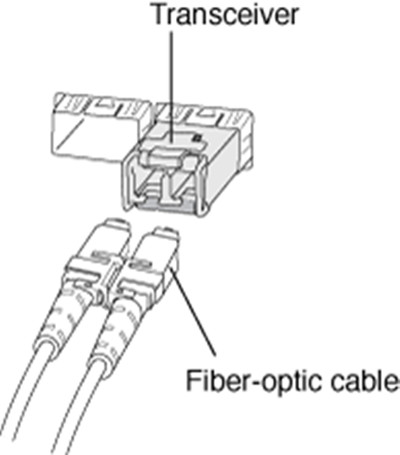August 08, 2016
Almost every user encounters the similar problem: the Internet is not fast enough. The slow response to net surfing isn’t just browser latency, but also about the network interconnections themselves. To put it simply, increased viewing of TV and downloading of videos further burdens the Internet. Despite some bandwidth-hunger applications are faster than ever, the carrier backhaul networks slow everything down. On top of that, the cloud computing applications require considerably faster networks. Coming to this solution are fiber optic networks.
In each fiber optic network, a fiber optic transceiver and an optical fiber constitute the fiber optic data link. The transceiver is designed to operate over specific fiber cable type. For instance, SFP-10G-SR, a Cisco compatible 10GBASE-SR SFP+, is manufactured to work on multi-mode fiber (MMF). Optical fiber has been adopted in many high-performance optical networks. In a word, fiber optics offers other benefits besides simple speed. These benefits do, however, require expertise in the design of fiber optic cable in order to prevent difficult-to-diagnose failures.

Just mentioned above, fiber optics boasts of many advantages, some of which pack a significant punch in aerospace and defense applications. Actually, airborne applications were among the first to adopt fiber-optic-based design. In such an environment, weight, reliability, and immunity from electromagnetic interference (EMI) are critical concerns. And given the use of airborne platforms in graphics- and processing-intensive Command, Control, Communications, Intelligence, Surveillance, and Reconnaissance (C3ISR) functions, an enclosure must be designed to support extremely high-performance computing.

- Fiber vs. Copper: Cost & Weight
To compare the overall costs of the configuration in the boxes shown above through fiber and Quadrax, a few basic assumptions must first be made. First, for shorter cables, little cost difference exists between optical fiber and Quadrax; however, fiber becomes more expensive for longer runs. Regarding the connectors, while fiber connectors are more expensive than Quadrax, they also support a higher density.
When it comes to the weight savings in the same configuration, though, the reasons to opt for this increased cost become obvious, particularly in airborne and other weight-sensitive applications. While connector weights are roughly the same, the optical cable itself is significantly lighter than Quadrax. Such weight economy also has the added benefit of making optical fiber much less prone to the chafing that arises due to vibration, which can significantly impact Quadrax.
All those explain why fiber-based designs have been so widely adopted in airborne applications ahead of others.
Once it’s decided that fiber optic cable benefits make is applicable for the environment, fiber-specific routing and handling expertise is required to ensure that the resulting system provides the performance, serviceability, and long-term reliability required by applications. Providing strain relief, and minimizing bend radius for optical fiber, are of paramount concern. To understand some basics of handling fiber optic cable, it’s necessary to know about the use of pull-proof connectors with loose-structure cable and non-pull-proof connectors with tight-structure cable, where tight and loose are defined as whether movement is permitted between the outer jacket and the strength member.

Additionally, there are also some other considerations about fiber optic cable bend radius. This is a great concern for this delicate optical fiber since time-to-failure decreases precipitously with increasing bend stress. Much of the bend radius can be ameliorated with the addition of service loops, along with a scrupulous adherence to maintaining the fiber bend radius larger than one inch during installation in addition to final dressing and operation.
Fiber bending occurs in more than one way. Both installation and thermal cycling can result in internal stresses within the cable that create compression "ripplesâ€. In other words, multiple bends may occur within the body of the cable of extremely small radius, which greatly increases the possibility of cable failure.
When a fiber optic cable is seated against the face of a connector, the face of the cable core and cladding will be pushed into the body of the cable by a very small amount, on the order of millimeters, at both ends. Moreover, when a fiber cable is subjected to thermal cycling, swinging back and forth between the extremes of its operating temperatures, this can cause the cable jacket to shrink slightly. In both cases, the result is that the cable core and cladding become compressed within the jacket, and is not free to move in a manner that would relieve the stress. This increases light loss across the fiber and heightens the chance for what’s called a "blocked cable failure†(shown below).

These issues can be addressed via thermal preconditioning, the use of service loops, and limits placed on the restriction of fiber movement. Lastly, the use of an optical backscatter reflectometer can also return useful information about the internal structure of a fiber-optic cable, including very small compression-caused bends within the jacket.
Owing to its speed, weight-saving benefits, fiber optics has been considered as the basic clay of the telecommunications and commercial IT industries. As a professional fiber optic product manufacturer, Fiberstore supplies all kinds of fiber cables with different connectors, like LC fiber cable, MTP cable, SC fiber optic cable, etc.. You can visit Fiberstore for more information about fiber optic cables.
Posted by: fernxu123 at
02:25 AM
| No Comments
| Add Comment
Post contains 878 words, total size 8 kb.
35 queries taking 0.1125 seconds, 80 records returned.
Powered by Minx 1.1.6c-pink.









